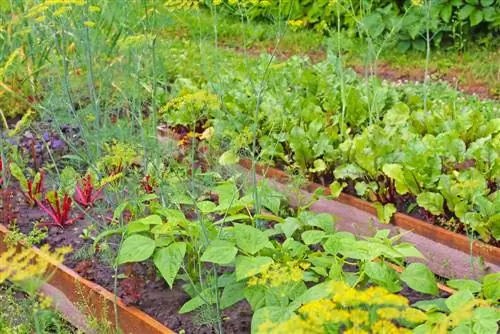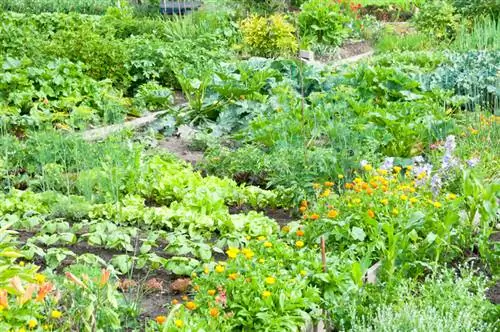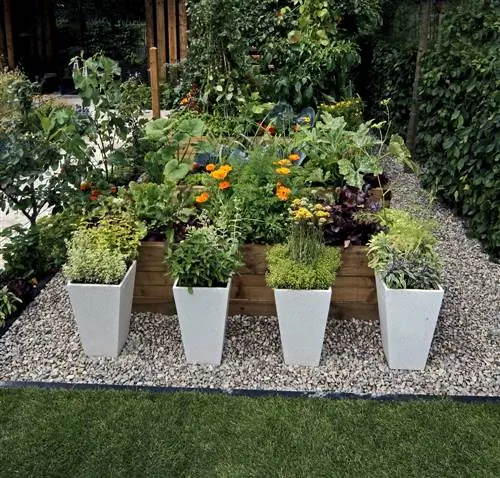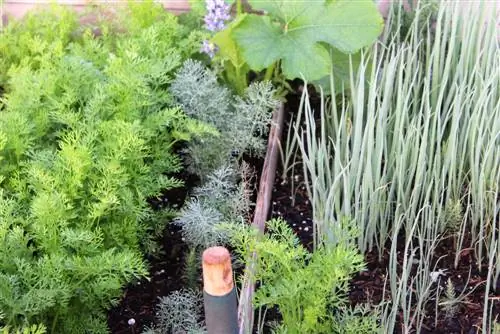- Author admin [email protected].
- Public 2023-12-16 16:46.
- Last modified 2025-01-23 11:21.
Knowing which plants make good neighbors in the vegetable patch has numerous advantages. Not only does this ensure a rich harvest, pest insects also avoid your vegetable patch and you have to do far less to combat these unwanted guests. In addition, a mixed culture looks great, because bright orange marigolds or marigolds planted between onions and carrots, surrounded by herbs, become the highlight of the garden.

Which plants go together in the vegetable patch?
In the vegetable patch, for example, beans go well with strawberries, cucumbers and potatoes, but not with peas and onions. Tomatoes harmonize with garlic, carrots and spinach, but should be kept away from fennel and potatoes. You can find a detailed table about good and bad plant neighbors in the article.
How do good neighbors benefit from each other?
There are a variety of reasons for certain plant neighborhoods:
- Pests don't like the smell of the neighboring plants and therefore stay away.
- Beneficial insects are attracted.
- Neighboring plants attract insects and thereby ensure good pollination and a richer harvest.
- Sensitive plants are shaded by tall, sun-hungry plants.
- The space in the bed is optimally utilized.
- Better nutrient utilization of the soil.
Which plants should be planted next to each other?
“The strongest plant cannot thrive if the neighbor doesn’t like it.” The Schiller quote could be modified in one way or another, it’s about the vegetable patch. The following table shows which vegetable plants thrive when planted next to each other:
| Plant | good neighbors | bad neighbors |
|---|---|---|
| Beans | Savory, strawberries, cucumbers, potatoes, cabbage, lettuce, lettuce, celery, beetroot, tomatoes | Peas, fennel, garlic, leek, onions |
| Strawberries | Bush beans, garlic, lettuce, leeks, radishes, chives, spinach, onions | cabbage |
| Potatoes | Broad beans, chamomile, nasturtium, cabbage, caraway, corn, horseradish, mint, spinach, marigold | Pumpkin, tomatoes, celery, sunflowers |
| Leek | Endive, strawberries, chamomile, cabbage, lettuce, carrots, salsify, celery, tomatoes | Beans, peas, beetroot |
| Corn | Beans, cucumbers, potatoes, lettuce, pumpkin, melons, tomatoes, zucchini | Beetroot, celery |
| Carrots | Dill, peas, garlic, leek, chard, radishes, radish, rosemary, sage, chives, lettuce, salsify, tomatoes, onions | |
| Radish and radish | Beans, peas, nasturtiums, cabbage, lettuce, chard, carrots, spinach, tomatoes | Cucumbers |
| Celery | Bush beans, cucumbers, chamomile, cabbage, leeks, tomatoes | Potatoes, lettuce, corn |
| Asparagus | Cucumbers, lettuce, parsley, lettuce, tomatoes | Garlic, onions |
| Spinach | Strawberries, potatoes, cabbage, radishes, radishes, celery, runner beans, tomatoes | |
| Tomatoes | Bush beans, nasturtiums, garlic, cabbage, lettuce, leek, corn, carrots, parsley, lettuce, radishes, radish, beetroot, celery, spinach | Peas, fennel, potatoes |
| Zucchini | Nasturtium, corn, beetroot, runner beans, onions | |
| Onions | Savory, dill, strawberries, cucumbers, chamomile, lettuce, carrots, beetroot, salsify | Beans, peas, cabbage |
Many other plants could be found that harmonize very well. You can find even more comprehensive tables in garden shops (€24.00 on Amazon).
Which neighbors are particularly unfavorable?
There are some plants that you absolutely should not put next to each other:
- Lettuce and parsley
- Fennel and tomatoes
- Bush beans and onions
- Cabbage and onions
- Tomatoes and peas
- Peas and beans
- Potatoes and sunflowers
- Potatoes and tomatoes
Tip
If you look at different sources, the information about good and bad neighbors does not always agree. This depends on the soil and location, but also on the choice of variety. Therefore, write down your own observations and include your own experiences in the planting plan for the next garden year.






